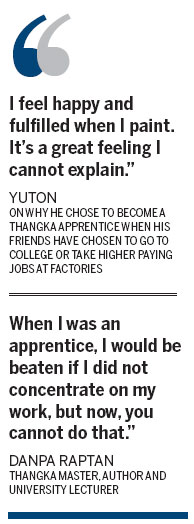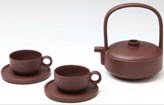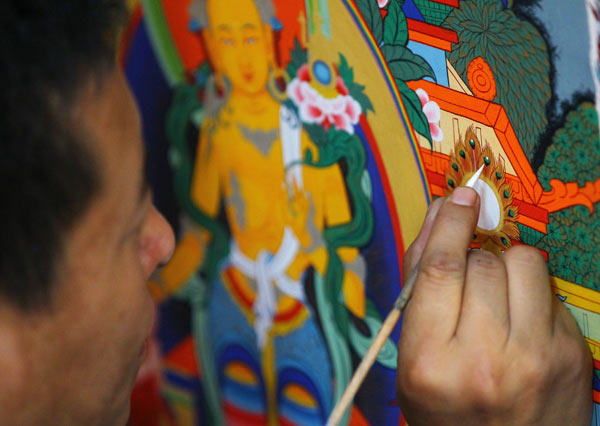China Face
Thangka craftsmen re-create religious icons
Updated: 2011-08-21 09:03
By Cui Jia (China Daily)
Thangka craftsmen have faithfully re-created Tibetan religious icons for generations, passing down the art from masters to apprentices in a heritage chain that still keeps tight links today. Cui Jia finds out more about the passion and the motivation that drive these devout artists.
Yuton carefully dips his tiny paintbrush into a pot of clean water, and holds his breath as he just as carefully fills in the color on the thangka in front of him.
The Tibetan art of religious painting requires a precise hand and a strong faith, and it has been passed down through an elite group of craftsmen for more than 600 years. The composition of each piece is highly geometric, and all the elements such as the arms, legs, eyes, nose, ears of the Buddha, and the various ritualistic implements, are laid out on a systematic grid of angles and lines.
Yuton is 20 years old and he has been a thangka apprentice for just three years, so he is only allowed to fill in the background colors. The more delicate details will be left to older apprentices and to his master, Nyima Gyndo. Because thangka art is explicitly religious, all symbols and allusions must be in accordance to strict guidelines laid out in the Buddhist scripture, and it will take a lifetime of learning to remember them all.
Yuton works quietly in a corner of one of many thangka workshops in the famous Barkhor Street in Lhasa, capital of the Tibet autonomous region. His dream is to own a thangka workshop and have his own apprentices one day. Unlike Nyima Gyndo, his teacher and the owner of the workshop who has already painted thangkas for more than 35 years, Yuton still has a long way to go.
 |
|
Yongten has overcome incredible odds to become a thangka artist, and he wants to learn all he can so he can bring it back home to Qinghai. [Photo by Zou Hong / China Daily] |
Gyndo's senior apprentice, Gyasto, 31, has been with him for 17 years. To him, the master has entrusted the task of filling out the eyes of the image, highlighting them with powdered gold. The colors used for thangka painting are water-soluble, and both mineral and organic pigments are used, tempered with a herb and glue solution.
Dotting the eyes of the Buddha is the finishing touch.
 |
The sizes of the canvases are rigidly controlled. On average, a medium-sized thangka measuring 90cm by 63cm will take three artists in the workshop three months to complete.
A skilled thangka artist will generally select from a variety of set items to include in the composition, ranging from alms bowls and animals, to the shape, size and angle of a figure's eyes, nose and lips.
"It is all about attention to details and a fine thangka artist needs to think of Buddha with his every stroke because it is not just a painting," Gyasto says. "To become a thangka painter is very demanding, let alone become a master."
There is also the exactness of the demands. One rule requires that the height of the Buddha must be equal to the width of 125 of his fingers, whereas his face is to be exactly as tall as the width of 12.5 fingers. An apprentice can only achieve such precision after practicing for years.
Yuton is from Lhasa's Tohling Dechen county and he picked up the paintbrush when he was 17 because thangka artists are highly respected in Tibet, where the majority of the population is Buddhist.
"Being a thangka artist is a lifestyle choice and I will do this for the rest of my life," Yuton says with confidence. Many of his friends chose to go to university or work in factories after graduating from high school.
Yuton has chosen a hard discipline. Thangka artists must have proper training in not just technical skills but also in religious knowledge. The artists pray before starting to paint a new thangka, often on a specially picked auspicious day in the Tibetan calendar.
For Yuton, the day starts at 9 am, and the first thing he has to do is to pray and read Buddhist scripture to put him in the right frame of mind.
"My teacher told me to listen to Buddha's voice when I draw," he says, with reverence. After an hour of compulsory scripture reading, he will start painting under the guidance of his master, or the senior disciples.
"Young thangka artists like Yuton are easily distracted these days with things like mobile phones or comupter games," Gyasto says. "They are definitely less focused than when I was an apprentice at their age."

Specials

Biden Visits China
US Vice-President Joe Biden visits China August 17-22.

Star journalist leaves legacy
Li Xing, China Daily's assistant editor-in-chief and veteran columnist, died of a cerebral hemorrhage on Aug 7 in Washington DC, US.

Hot pots
Tea-making treasures catch the fancy of connoisseurs as record prices brew up interest
